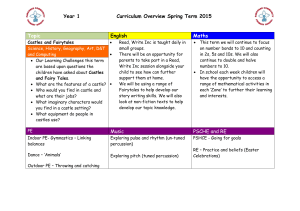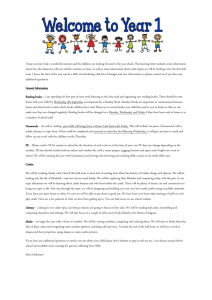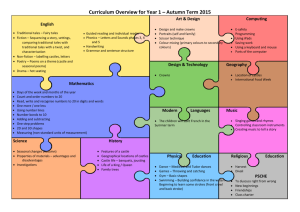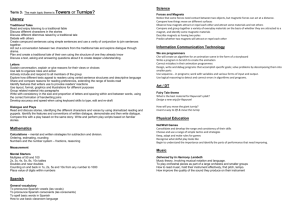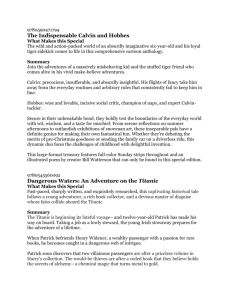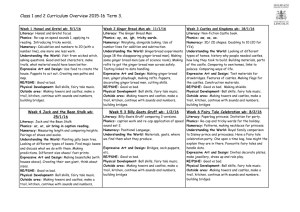PSHE `Keeping Safe` The children will look at why we have rules
advertisement
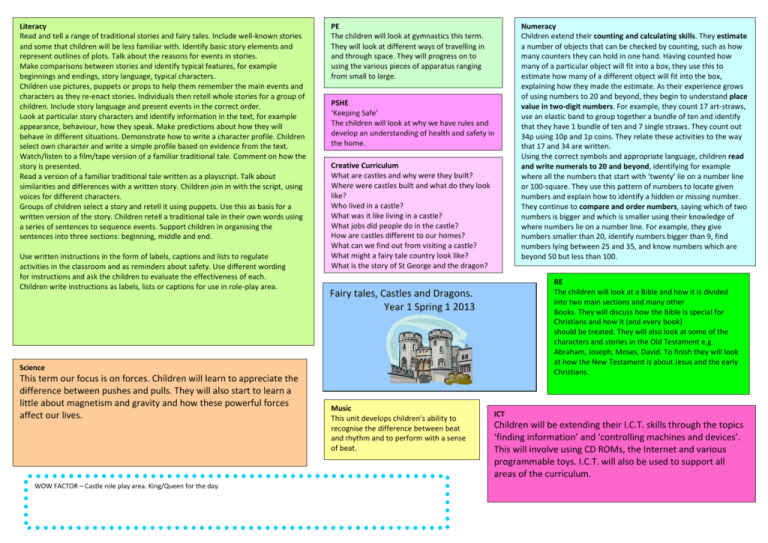
Literacy Read and tell a range of traditional stories and fairy tales. Include well-known stories and some that children will be less familiar with. Identify basic story elements and represent outlines of plots. Talk about the reasons for events in stories. Make comparisons between stories and identify typical features, for example beginnings and endings, story language, typical characters. Children use pictures, puppets or props to help them remember the main events and characters as they re-enact stories. Individuals then retell whole stories for a group of children. Include story language and present events in the correct order. Look at particular story characters and identify information in the text, for example appearance, behaviour, how they speak. Make predictions about how they will behave in different situations. Demonstrate how to write a character profile. Children select own character and write a simple profile based on evidence from the text. Watch/listen to a film/tape version of a familiar traditional tale. Comment on how the story is presented. Read a version of a familiar traditional tale written as a playscript. Talk about similarities and differences with a written story. Children join in with the script, using voices for different characters. Groups of children select a story and retell it using puppets. Use this as basis for a written version of the story. Children retell a traditional tale in their own words using a series of sentences to sequence events. Support children in organising the sentences into three sections: beginning, middle and end. Use written instructions in the form of labels, captions and lists to regulate activities in the classroom and as reminders about safety. Use different wording for instructions and ask the children to evaluate the effectiveness of each. Children write instructions as labels, lists or captions for use in role-play area. PE The children will look at gymnastics this term. They will look at different ways of travelling in and through space. They will progress on to using the various pieces of apparatus ranging from small to large. PSHE ‘Keeping Safe’ The children will look at why we have rules and develop an understanding of health and safety in the home. Creative Curriculum What are castles and why were they built? Where were castles built and what do they look like? Who lived in a castle? What was it like living in a castle? What jobs did people do in the castle? How are castles different to our homes? What can we find out from visiting a castle? What might a fairy tale country look like? What is the story of St George and the dragon? RE The children will look at a Bible and how it is divided into two main sections and many other Books. They will discuss how the Bible is special for Christians and how it (and every book) should be treated. They will also look at some of the characters and stories in the Old Testament e.g. Abraham, Joseph, Moses, David. To finish they will look at how the New Testament is about Jesus and the early Christians. Fairy tales, Castles and Dragons. Year 1 Spring 1 2013 Science This term our focus is on forces. Children will learn to appreciate the difference between pushes and pulls. They will also start to learn a little about magnetism and gravity and how these powerful forces affect our lives. WOW FACTOR – Castle role play area. King/Queen for the day. Music This unit develops children's ability to recognise the difference between beat and rhythm and to perform with a sense of beat. Numeracy Children extend their counting and calculating skills. They estimate a number of objects that can be checked by counting, such as how many counters they can hold in one hand. Having counted how many of a particular object will fit into a box, they use this to estimate how many of a different object will fit into the box, explaining how they made the estimate. As their experience grows of using numbers to 20 and beyond, they begin to understand place value in two-digit numbers. For example, they count 17 art-straws, use an elastic band to group together a bundle of ten and identify that they have 1 bundle of ten and 7 single straws. They count out 34p using 10p and 1p coins. They relate these activities to the way that 17 and 34 are written. Using the correct symbols and appropriate language, children read and write numerals to 20 and beyond, identifying for example where all the numbers that start with ‘twenty’ lie on a number line or 100-square. They use this pattern of numbers to locate given numbers and explain how to identify a hidden or missing number. They continue to compare and order numbers, saying which of two numbers is bigger and which is smaller using their knowledge of where numbers lie on a number line. For example, they give numbers smaller than 20, identify numbers bigger than 9, find numbers lying between 25 and 35, and know numbers which are beyond 50 but less than 100. ICT Children will be extending their I.C.T. skills through the topics ‘finding information’ and ‘controlling machines and devices’. This will involve using CD ROMs, the Internet and various programmable toys. I.C.T. will also be used to support all areas of the curriculum.
